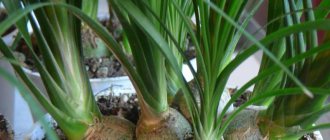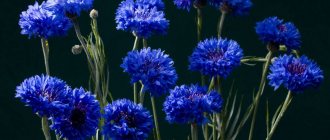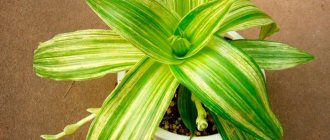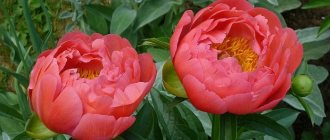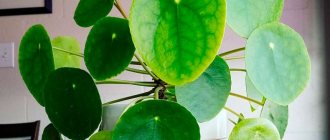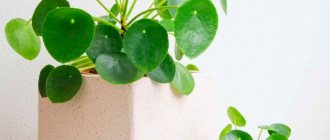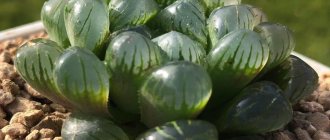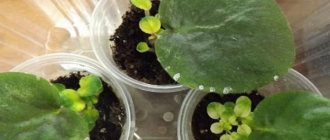Decorative foliage plants can offer a strikingly rich selection of attractive accents for decorating rooms. One of the most beautiful compact plants in terms of both shape and texture are Pileas. They have so many species and varieties that it is sometimes difficult to believe that the bushes belong to the same genus. Unpretentious, quite hardy, Pileas may not be distinguished by their durability, but they have no equal in the luxury of small foliage. Growing them is not difficult, nor is it difficult to independently obtain new plants to replace old, rather short-lived specimens.
Pilea wrapped. © Lyubo Gadzhev
Features of Pilea
Pilea is a hardy plant, reaching a height of 0.4 m and having decorative foliage. This plant is most often grown in winter gardens, warm flower beds and display cases. Pilea Cadieu differs from other species in its very rapid growth, which is of particular value for gardeners who use it when arranging compositions of various flowers. Small unisexual flowers are most often collected in axillary racemes. The plant distributes its fruits in an extremely unusual way, which is similar in its mechanism to ejection. By the time of fruiting, the sterile stamens (staminodes) grow greatly and only slightly support the fruit hanging over them. In a ripe fruit, the connection with the plant is greatly weakened. At this time, the sterile stamens straighten and throw the fruit up to a distance of one hundred meters.
Botanical description of a houseplant
Small-leaved pilea (microphylla pilea) is a herbaceous perennial species belonging to the nettle family.
Did you know? Small-leaved pili have another, “folk” name - artillery tree. These plants have an amazing feature: during the bud blooming period, upon contact with a flower, it begins to shoot out small clouds of pollen, spreading it over vast distances.
Pilea has the following appearance characteristics:
- the culture is bushy, grows approximately 15 cm in height, but some specimens can stretch up to 35–40 cm;
- shoots are straight or creeping, thin, densely branched from the base;
- foliage is light green, fleshy, opposite, from tiny (5 mm) to larger (50 mm); the appearance of the leaves is lanceolate, oval or perfectly round; the leaves are convex on top, with a glossy sheen, with entire or jagged edges;
- flowers - unisexual inflorescences-tassels with inconspicuous, small flowers sitting in the axils of the leaves.
Brief description of cultivation
- Bloom . It is observed in June–October, but the flowers do not have high decorative value. At home, Pilea is grown as an ornamental foliage plant.
- Illumination . A large amount of bright diffused light is needed. Do not expose the flower to direct sunlight.
- Temperature regime . Throughout the year, the air temperature in the room should be about 25 degrees. But there are species that are more comfortable in winter at temperatures of about 10 degrees. However, most species may suffer when temperatures drop to 17 degrees or below.
- Watering . In the spring-summer period, the flower needs to be provided with such a watering regime so that the soil mixture in the pot is slightly moist (not wet) all the time. In winter, watering is carried out only when the substrate is 1/5 dry in depth.
- Air humidity . It should be elevated. Experts advise placing open vessels filled with water next to the flower, or you can pour wet pebbles into the tray. The foliage should not be moistened.
- Fertilizer . In the spring-summer period, fertilizing is carried out once every 7 days and for this purpose mineral complex fertilizers for decorative and deciduous plants are used. In winter, the amount of fertilizing is reduced to once every 4 weeks.
- Rest period . Observed in October–February.
- Transplant . The flower is replanted every year at the beginning of the growing season.
- Soil mixture . It should be humic, slightly acidic or neutral. Its composition should include sand, peat, humus and turf soil in equal parts.
- Reproduction . By cuttings and seeds.
- Harmful insects . Mealybugs, thrips, spider mites and scale insects.
- Diseases . Problems with Pilea foliage can only arise if it is not properly cared for.
Pilea Cadieux - home care. [Hope and Peace]
Difficulties in growing
Among the possible difficulties in maintaining small-leaved crops are the following problems:
- The leaves shrink and fall off . The reason may be that the room temperature is too high or too low. The problem is solved by organizing the optimal temperature regime (+16…+23°C).
- The foliage became soft, began to turn black and fall off, and the bases of the shoots began to rot . The reason is excessive watering of the plant. It is recommended to remove rotten and withered parts of the plant, replace the soil in the pot and adhere to the correct watering schedule.
- The leaves became pale in color and wilted . Perhaps the cause was excessive lighting. It is necessary to move the flower to partial shade.
- The leaves were crushed and the shoots stretched. The reason is excessive distance from the light source. The problem can be solved by forming a bush, pinching off the tops of elongated shoots. Then the flower is transferred to a bright room or a phytolamp is placed near it, periodically turning the pot around and exposing each side of the bush to the light.
- The leaves are covered with yellow or brown spots . This happens when the foliage is exposed to direct sunlight, as a result of which the delicate foliage gets burned. In this case, the flower needs light partial shade.
- Root rot. Pilea can get sick due to overwatering. The first signs will be the wilting of the plant. The bush and earthen ball must be treated with fungicides (Previkur Energy, Fitosporin, Topsin-M, etc. - according to the instructions).
Indoor plants can also be damaged by parasites:
- Spider mite . The pest attacks the Pilea when the air in the room is too dry. When parasites are detected, the bush is washed under running hot water (+40°C), dried well and treated with Fitoverm, Neoron, and Actellik insecticides.
- Mealybug . It usually settles on a plant in winter, when the bush is too waterlogged and the soil is supercooled. Insecticides will be effective against the parasite: “Biotlin”, “Aktara”, “Calypso”.
All of these drugs are used strictly according to the instructions.
It is not for nothing that Pilea smallifolia is called a favorite indoor crop among gardeners. Her curly plants, although they do not have too flashy foliage, are able to influence the calm atmosphere in the apartment. If you follow all the above tips, then this modest decorative flower will serve as a decoration for your home interior for a long time.
Pilea care at home
Illumination
Pilea needs bright but diffused light. Direct rays of the sun should not fall on the bush. A western or eastern window sill is best suited for growing such a flower. If you decide to place it on a south window, then be sure to provide it with diffused light, or you can move it deeper into the room. In the summer, the plant can be moved outside, but you need to choose a place for it that will be reliably protected from direct sunlight. Remember that in the cold season, Pilea also needs a lot of light, but if there is too little of it, the color of the foliage of the bush may change, which will negatively affect its decorative effect.
Temperature
The flower grows best throughout the year at a temperature of about 25 degrees. In winter, Pilea Kadiera grows well at temperatures up to 15 degrees, and Pilea peperomyoid - at 10 degrees. If you grow other species, then remember that the room where the bush is located should not be colder than 17 degrees. In winter, a draft can cause the death of a plant.
Watering
In the spring and summer, the substrate is moistened immediately after its top layer dries. To do this, you need to use well-settled water. In the cold season, watering is carried out two days after the top layer of the soil mixture has dried. Pilea is one of those plants that can much more easily tolerate drying out of an earthen clod than stagnant liquid in the substrate. Make sure that the substrate in the container is always slightly damp. With excessively abundant watering, the foliage may fade and wither, especially in the cold season.
Spraying
Indoor Pilea needs high air humidity, so you will have to monitor the humidity level in the room. It is highly undesirable to moisten foliage with a spray bottle, as this may cause it to lose its decorative effect. To increase humidity, the flower pot should be placed on a tray filled with moistened pebbles or expanded clay. However, make sure that the bottom of the container does not come into contact with the liquid. Instead, you can place an open vessel filled with water near the flower.
Fertilizer
In the spring-summer period, flower feeding is carried out regularly once every 7 days, and in autumn and winter - once every 4 weeks. To do this, use a complex mineral for indoor flowers; the concentration of the nutrient mixture should be as recommended by the manufacturer.
Trimming
When grown indoors, Pilea grows quite quickly. Since young bushes are much more spectacular than old ones, pruning should be done annually, and the cut stems should be used as cuttings. To increase the splendor of the bush and to avoid its exposure, you should systematically pinch the stems.
Pilea transplant
Household Pilea needs to be replanted every year. To do this, use humus soil with a slightly acidic or neutral reaction. So, you can take a soil mixture consisting of humus and turf soil, as well as sand and peat (they are taken in equal parts). Since the flower has a superficial root system, you need to use a small pot for replanting. In order to avoid stagnation of liquid in the substrate, it is necessary to make a good drainage layer at the bottom of the container. If desired, Pilea can be grown hydroponically.
Pilea. Transfer.
Reproduction methods
Pilea can be propagated by cuttings and seeds. Some species of this plant reproduce independently by seeds. If you decide to propagate it by cuttings, then this can be done at any time of the year. For rooting, the cuttings are placed in a container with water or planted in sand (loose substrate). After rooting, the cuttings are planted in a small pot filled with a soil mixture consisting of greenhouse and deciduous soil, as well as sand (1:1:1).
How to transplant
The rules for growing at home necessarily include optimal transplantation:
- The container intended for planting the plant must be washed and treated with an antiseptic. This approach will provide the crop with adequate protection from the development of infectious diseases and pathogenic fungi.
- The root system of the plant should be as close as possible to the surface layer of soil. For this reason, a shallow but wide enough pot is selected for transplantation.
- The presence of a drainage layer for this crop is a mandatory requirement.
The soil for planting is used ready-made; if desired, you can prepare the optimal soil for growth with your own hands (leaf soil, humus, peat, sand in a ratio of 3:1:1:1).
Possible problems
If the Pilea is not properly cared for, then problems may begin with it:
- The foliage dries up and flies away . If the room is colder than 12 degrees or warmer than 27 degrees, then the leaf plates will wrinkle, dry out, and fly around. This can also happen due to drying out of the earthen coma.
- The leaves are withering . If liquid regularly stagnates in the substrate, this can cause limp foliage to appear; after a while it will turn black and fly off, and the shoots will become soft.
- The leaves are turning pale . Excessively intense lighting can cause foliage to become faded, limp and a little translucent. At the same time, its edge dries and turns brown. Due to excessively poor lighting, the edges of the leaf blades will also turn brown and dry out, while they themselves lose their spectacular color, and young leaves grow small, the stems become elongated.
- Spots on leaves . As a result of exposure of the bush to direct rays of the sun, sunburn may form on the foliage, looking like yellow spots, which eventually turn brown.
- Flying leaves . If only the lower leaf plates fly around, then this is quite normal and is associated with the aging of the plant. In this case, it is recommended to cut several cuttings from the bush and grow a young plant from them.
- Harmful insects . Thrips, mealybugs, spider mites and scale insects can settle on the pilea.
Diseases and pests
Like most well-known houseplants, Pilea is susceptible to pests. Description of the flower, according to which one can indicate the presence of a disease:
- Drying and premature falling of leaves.
- Change in leaf color. At the same time, both saturated and faded colors can indicate a violation of growth and development.
- Wilting foliage can be a sign of overwatering and decreased immunity.
Any appearance of mold, white plaque, or cobwebs on the surface of the leaves should alert the gardener. Also, danger signals are the appearance of small holes on the leaf and stem. Natural pests of this crop include spider mites, mealybugs, and scale insects.
Types of Pilea with photos and names
Pilea cadierei
This species is native to the tropical forests of Southeast Asia. The height of such a herbaceous perennial can be about 0.4 m. Young shoots are erect, but with age they become lodging. The bare and succulent stems are highly branched. Spectacular petiolate elongated oval leaf plates are pointed towards the top and have three veins. The leaves are about 20 centimeters long and 5 centimeters wide. The British call this species “aluminum plant”, and the Germans call it “silver pilea”. This is due to the fact that on the surface of the rich green or bluish-green foliage there are a pair of broken lines of silver color. During flowering, axillary racemes appear, consisting of small flowers. Young slender shoots begin to curl over time, resulting in an ampelous appearance. In order for the bush to be more lush, it will need systematic pinching.
Pilea microphylla
The height of such a herbaceous perennial is about 15 centimeters. The branching stems have lush foliage; if they come into contact with the surface of the soil, they quickly take root. The branches are similar in appearance to the fronds of a fern, they bend beautifully and have a large number of small bare greenish oval and round leaves, their length does not exceed 5 mm. Corymbose inflorescences are formed in the leaf axils and contain heterosexual and bisexual small flowers. Such a plant is popularly called “Artillery” or “Cannonier”; the fact is that the staminate flowers form a dusty cloud during the opening of the anthers. If you touch a Pilea parvifolia flower in the summer, it will release a haze of pollen.
Pilea nummulariifolia
This herbaceous perennial has stems that creep along the surface of the soil, reaching a length of about 0.4 m. Greenish round leaf plates grow on them. Over time, the bush grows and forms a carpet on the soil surface.
Pilea involucrata
The plant is a low bush, the height of which does not exceed 0.3 m. The shoots are erect. Opposite oval leaf plates have a point at the apex and reach a length of about 70 mm. The greenish leaves along the veins are lumpy brown. This species is widely used for hybridization.
Pilea peperomioides
The flower has a rigid stem and rounded leaf blades.
Pilea repens
The height of the bush, which has creeping shoots, is about 25 centimeters. Opposite smooth rounded leaf plates reach up to 25 mm in length and have a wavy edge. The front surface of the plates is dark green with a copper tint, and the back surface is purple.
Pilea spruceana
This plant comes from Peru and Venezuela. Short-petioled, oppositely located leaf plates of an ovoid or round shape, rotated 180 degrees, can be blunt or pointed at the apex. Foliage color is various shades of bronze or silver.
Pilea "Bronze"
The height of erect shoots is about 0.3 meters. Opposite oval leaf plates are pointed at the apex and have a length of up to 70 mm. They are silvery, wrinkled, and dark green along the veins. The plate may also have a silver stripe running along the central vein, with a dark green edge.
Pilea "Norfolk"
Scientists still have not figured out exactly how this form appeared. This herbaceous perennial has young stems that are erect, while mature stems are lodging. On the surface of the rich green wrinkled velvety leaf plates there are small bristly hairs. The veins of the foliage are brownish-red.
Pilea "Silver Tree"
The origin of this hybrid also remains a mystery. It is a spectacular, actively climbing, perennial sawweed. The oval, bronze-green foliage has a jagged edge and pubescence consisting of white or red hairs. A silver stripe runs down the center of the plate, and on its surface there are many spots of the same shade.
Pilea peperomiiformes Money tree from Asia, care and watering.
Reproduction
Pilea is propagated in 2 ways:
- By cuttings.
- Seed.
Cuttings
The simplest and most popular method among gardeners. For propagation, apical cuttings are used. They are cut throughout the year, even in winter.
The procedure is carried out as follows:
- Choose a thin shoot.
- Cut a cutting up to 10 cm from its top with 2-3 pairs of leaves.
- Place the cuttings in water for rooting. It is possible to plant in a loose substrate, for example, sand, to a depth of 5-6 cm.
- As necessary, water is added and the substrate is moistened.
- After the roots appear, the cuttings are placed in cool conditions for hardening for 7–14 days.
Growing from seeds
The seed method is only suitable for certain types of Pilea.
It is carried out like this:
- Before planting, moisten the substrate.
- Seeds are placed at a depth of 1–1.5 cm.
- The container is covered with film or glass.
- The crops are periodically sprayed with warm, settled water from a spray bottle.
- Every day the shelter is removed for some time for ventilation.
- After the sprouts appear, the cover is removed.
- When 2 leaves appear, a pick is made.
- After the formation of 5-6 leaves, transplantation to a permanent place is organized.
Variety of species
Almost all plants belonging to the decorative foliage category are distinguished by a wealth of various and attractive accents suitable for decorating any room. Some of the most beautiful plants in terms of color, texture and shape are the rather compact plants - Pileas. They include such a large number of varieties and varieties that it is even difficult to believe that all these bushes belong to the same genus.
Unpretentious and quite hardy Pileas, although they do not differ in life expectancy, have no equal in the luxury of their small foliage. They are grown quite simply, and propagation is not at all difficult.
Kinds
The main advantage of the plant is diversity. Some of them are so original that it is impossible to guess their relationship with other Pileas. Some have velvety luxurious leaves, others are glossy. And differences in sizes and shapes can completely confuse anyone.
1. Pilea parvifolia is a plant that captivates with a huge number of small leaves on drooping, recumbent shoots. This Pilea looks wonderful when grown at home among the interior of the room. Miniature fleshy leaves give it a wonderful “curly” quality. The effect is enhanced by branching and spreading shoots. The color of this pilea is quite bright, mostly in light colors. The convexity of the leaf plates is enhanced by a glossy shine. The series of small-leaved plants also includes a dwarf species, previously known as mossy pilea, which looks like a hummock of moss.
2. Pilea thickifolia is a velvety beauty, a very popular species among gardeners. Thanks to the reddish-green leaves with a textured, bumpy surface and light stripes along the edges, they appear velvety and powdered with light dust.
3. Pilea coinifolia (photo presented in the article) is a ground-blooded plant that is a “curly” bush. Its leaves, unlike the small-leaved variety, are round (in the form of coins), with a very delicate whitish-green color. It takes good cuttings and creates a wonderful cascade or a spectacular elegant rug.
4. Pilea Spruce is an outlandish, rather rare plant that grows only up to 20 centimeters in height. It stands out for its matte folded leaves with a basic brownish-reddish tint, with jagged edges and longitudinal stripes. All this, together with the pearlescent shine of the leaves, gives the plant a resemblance to snake skin or lizard skin.
5. Pilea involucra captivates with bubbly projections on leaves with a copper, red or bronze-green color. She brings original metallic effects to the interior. The height of the bushes reaches 30 cm. The surface of its leaves is a bit reminiscent of Byzantine chistets, but its bright green color, through which patterns of dark brown veins are visible, looks very original.
6. Peperomyoid (the article shows a photo of the pilea). Caring for this miracle, like other species, is not difficult. The flowering of this plant is very difficult to notice, and it occurs extremely rarely when grown indoors, but its foliage may well compensate for such a deficiency. This pilea is luxurious: almost perfectly round leaves grow in a bunch on a green-brown short stem.
7. Pilea Cadieu has green leaves with spectacular silver stripes, emphasizing the oval shape of fairly large leaves (length - 10 cm, width - more than 4 cm). The gloss is clearly visible on the beautifully arching leaves. The height of the bushes reaches 40 centimeters.
Pilea Lebanese, appressed, creeping - all these are magnificent varieties of the described plant, which are popular in floriculture.
What does Pilea Cadieu look like?
The height of the shoots is from 30 to 40 cm. The stems located at the base are very thin, initially erect, but over time they bend and become highly branched. The leaves can be lanceolate or oval in shape, located opposite on the petioles. The length of the plate is about 8 cm, width - 5 cm. The surface of the leaf is shiny, rough to the touch, the color is dark green with two large convex stripes of silver color. The lines run on both sides of the median vein and are divided into fragments by green areas. The edges of the leaves are also framed with convex silvery inclusions. The glossy color is emphasized by the fact that the shape of the plates has a curved appearance.
For your information! The genus Pilea includes about 400 species. Flowers have no decorative value.
Care
Pilea flowers require special care at home. They prefer bright, diffused lighting. They do not like direct sunlight. They grow actively at a temperature of 25°C. They have a short rest period. They do not tolerate drafts and sharp gusts of wind well. They prefer systematic watering with soft water without chemical impurities. They love extra sprays. Require mandatory crown formation. They propagate using seeds and cuttings.
Humidity and temperature
Pilea coinifolia loves moderate humidity and warmth. Caring for her is not difficult. It is not demanding on temperature conditions either. Of course, a native of tropical forests is good at warmth and sufficient humidity, but creating such conditions is quite feasible. The optimal temperature, as noted above, is between 20-25 degrees in summer and about 16-20 degrees in winter.
It is important to remember that in winter the air temperature should not be allowed to drop below 10 degrees, as this may cause the plant to get sick.
The optimal air humidity should be 60%. Such conditions should be observed especially during the heating season. In addition to the above methods, you can use an air humidifier or decorative fountains.
